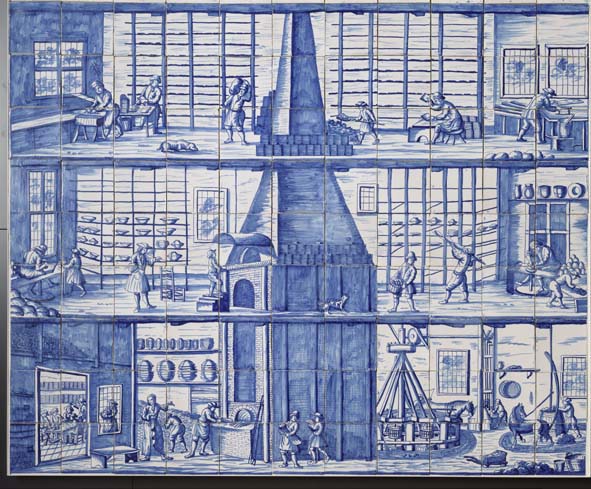
Kees Kaldenbach, art historian
New in 2014: XXL site Delftsaardewerk.nl
Outstanding art tours in the Rijksmuseum, Amsterdam and in Delft.

Tile factory, from a factory tableau in Bolsward, na 1737. Rijksmuseum, Amsterdam
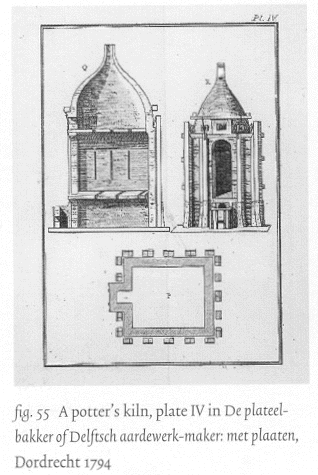 Each
independent Delft blue faience workshop
required an extensive and complicated array of buildings and
specialized trained personnel. The production center was the large
workshop in which all Delftware shapes were made, subsequently
painted and fired in the kiln. One required other buildings as well:
attics for drying the Delftware, warehouses, sheds for fire wood, hay
attics, and finally a sale-room in front of the house where the
master-baker lived.
Each
independent Delft blue faience workshop
required an extensive and complicated array of buildings and
specialized trained personnel. The production center was the large
workshop in which all Delftware shapes were made, subsequently
painted and fired in the kiln. One required other buildings as well:
attics for drying the Delftware, warehouses, sheds for fire wood, hay
attics, and finally a sale-room in front of the house where the
master-baker lived.
This is a link leading to the list of all known workshops. There is also a clickable map of Delft. For this clickable map of all workshops please go to Delft Blue section which is on view at www.xs4all.nl/~kalden
A large number of specialists were required within the workshop ("winckel" ) of each Delftware shop and it was of the utmost importance that each man finished his work on time so that the whole process could smoothly rotate like a giant clockwork.
Earth mixers (aardetrappers). With their bare feet they kneaded the earth paste which was delivered to the workshop by the earth washeries (aardewasserijen - see below) and removed little lumps.
Potters (draaiers) were divided in three classes: large (grootdraaiers) potters, round (ronddraaiers) potters and flat (platdraaiers) potters. They threw a lump of clay on the potters wheel, centered it and made the necessary objects in mass production. The potters wheel, which had a large fly-wheel below, was powered by foot. Grootdraaiers made large hollow shapes such as vases.
Shapers (vormers) of more refined shapes. They formed the more intricate spatial objects such as sets of jug and bowl for washing one's face.
Givers (gevers) dunked the objects in a tub filled with tin glaze liquid and set these covered objects out on racks to dry. This filled all of the pores of the clay and provides a good ground layer.
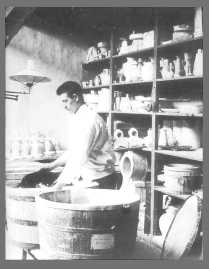 Painters
(schilders) With the help of a profiling wheel they
first marked circles on plates and saucers. As mass production was
necessary one seldom made decorations in free hand designs. Instead
one marked the plate, dish or saucer with a clever trick. First a
drawing was made on a sheet of paper or cardboard and this drawing
was punched along the main lines. This perforated image (called
pricked stencil, pricked transfer, in Dutch
pons,
spons) was used over and over again on
the object to be painted. One took a sponge or bag filled with
charcoal powder and dabbed it lightly on top of the paper. Finally
the painters could follow these tracings of black dots with their
paintbrushes. Because of the high kiln temperature the charcoal
evaporated.
Painters
(schilders) With the help of a profiling wheel they
first marked circles on plates and saucers. As mass production was
necessary one seldom made decorations in free hand designs. Instead
one marked the plate, dish or saucer with a clever trick. First a
drawing was made on a sheet of paper or cardboard and this drawing
was punched along the main lines. This perforated image (called
pricked stencil, pricked transfer, in Dutch
pons,
spons) was used over and over again on
the object to be painted. One took a sponge or bag filled with
charcoal powder and dabbed it lightly on top of the paper. Finally
the painters could follow these tracings of black dots with their
paintbrushes. Because of the high kiln temperature the charcoal
evaporated.
Floor workers (vloerwerkers). These covered the finished items with a thin layer of transparent lead glaze. These workers also chopped the wood which was needed for stoking the kiln at the proper moment, under the guidance of the master of the workshop who was either the owner or manager.
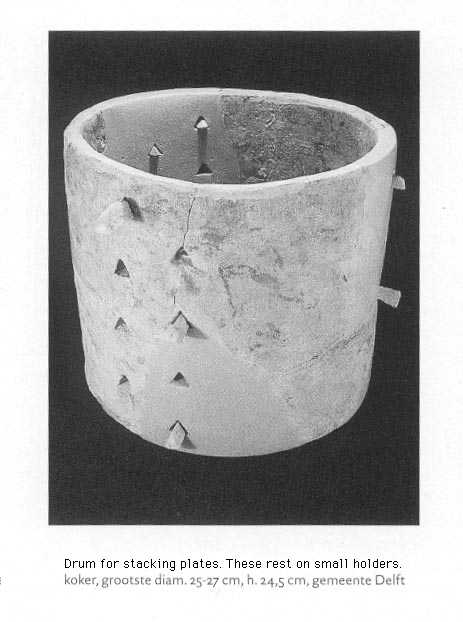 Container
makers (kokermakers). They took care of using the
proper containers. These were 24 cm. in height and had a diameter of
some 23 to 25 cm. These containers were completely filled with plates
during the first kiln process, called "biscuit firing" with a
pre-fired plate was placed at the bottom and on top for good shaping.
In between came the newly formed and dried plates, stacked from the
bottom to the top.
Container
makers (kokermakers). They took care of using the
proper containers. These were 24 cm. in height and had a diameter of
some 23 to 25 cm. These containers were completely filled with plates
during the first kiln process, called "biscuit firing" with a
pre-fired plate was placed at the bottom and on top for good shaping.
In between came the newly formed and dried plates, stacked from the
bottom to the top.
When firing painted plates one had to be more careful in order not to damage the glazing layer. One therefore stacked them in layers, each plate resting on three prongs at equal height. One the containers were filled one filled the kiln in the most economic way. Up to 9 to 11 containers were stacked on top of each other and many fitted next to each other. The regular oven had a height of over 2,5 meters (please note that the oven shown here on the tile tableau is exaggerated in height). The prongs left three small dot traces at the bottom of each object.
Wood choppers (houtklovers) selected the right fire wood and chopped it to the desired size.
The kiln could be carefully filled, fired, cooled and emptied once a week. In a 1668 survey the city magistrates calculated that of 26 Delftware workshops 13 had one kiln, another 13 had two kilns and only De Porceleine Schotel workshop had three. In order to curb overproduction, limits were set to the annual production of each kiln.

Then there were the other specialists who worked elsewhere but whose contribution was necessary for a smooth operation of a Delftware shop. These inculded:
Personnel of the earth washeries (aardewasserij) who prepared an optimal clay formula which was developed slowly out of experience. This formula was made of four kinds of earth from: 1) Marl from the region of Doornik / Tournai in Brabant, Flanders), 2) earth from Muhlheim at the Ruhr river (Germany), 3) so called 'black earth' and 4) 'Delft earth'. In 1742 there were no less than seventeen earth washeries along the banks of the Rotterdam canal or Schie. This is the waterway shown on Vermeer's 'View of Delft'. The earth was transported there, mixed and washed into a thin suspension, then fed through a copper or brass sieves and dried into a thick paste. This paste which consisted of quartz, clay and feldspar was finally transported in batches to the workshops.
Then there was the personnel of the paint grinding windmills (verfmaal-windmolens), of which six mills were left near Delft in 1742; furthermore one required personnel in a tin-ash-kiln which used costly ingredients like English tin (pewter) and lead, and sometimes other metal oxydes which provided the colour. Green tint was obtained from copper oxide, azurite or malachite. Purple was made with manganese dioxide. Yellow was made with arsenic oxide, and with mixtures of tin and lead oxides. Cobalt or 'zaffer' was made by calcining cobalt ore with quartz sand and potash (as a flux) resulted in for blue, and it did not come cheap: 38 guilders for 100 pounds. Two workshops, Grieksche A and Metaale Pot owned their own windmill.
The final product was sold to customers, not only in the Dutch Republic, but world wide. Transport was started on an inland freight ship (see my study of these ships in Vermeer's View of Delft) and afterwards loaded into other ships. Delftware was breakable and transport breakage continued to be a source of problems.
All of these phases in the process were managed by the Delftware master (meester-plateelbakker)of each workshop. A high investment of money was also necessary as there was a large time span between producing a batch of Delftware and actually receiving payment many months or even many years later on.
Masters & apprentices
All masters and apprentices working at this workshop had to be inscribed in the Delft St Luke Guild Book. In 1877 this book was published in a 120 page text by Obreen. In 2002 this text has been scanned and is now available and fully searcheable on this internet site. See the yellow field on top; first click the heading Delft Artists & Patrons and then click Obreen. The full text is in Dutch. Spelling varies; in order to find masters or apprentices of a faience workshop (plattielbackers, plateelbacker, platielbacker) search for the letters "plat".
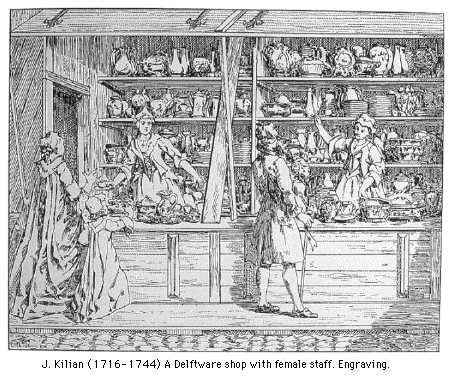 Last
but not least one may imagine the wife
of this Delftware master being very busy day to day as the manager of
the faience shop for customers, selling the finished goods. In fact a
business partnership between man and wife would evolve. If the master
himself died the widow would actually become the owner of the shop,
but she needed the expertise of another master to properly run the
technical side of the factory workshop. In the mean time she could
add the sign W (of widow) to the pottery mark. When widows
contemplated another marriage then courting another master faience
maker would be a quite logical choice. Because of this several workshops sometimes came into the hands of one
master-potter.
Last
but not least one may imagine the wife
of this Delftware master being very busy day to day as the manager of
the faience shop for customers, selling the finished goods. In fact a
business partnership between man and wife would evolve. If the master
himself died the widow would actually become the owner of the shop,
but she needed the expertise of another master to properly run the
technical side of the factory workshop. In the mean time she could
add the sign W (of widow) to the pottery mark. When widows
contemplated another marriage then courting another master faience
maker would be a quite logical choice. Because of this several workshops sometimes came into the hands of one
master-potter.
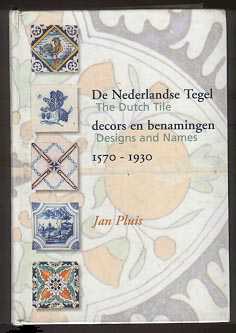 Delftware
Connoisseurship
Delftware
Connoisseurship
A serious collector of Delftware will attempt to identify and date the object. On Delft blue plates and other Delftware objects such as jugs, a potters mark may give a first indication. One should always treat potters marks with caution. Marks must be considered as just one indication.
A correct dating of Delft blue tiles is much more complicated; there is usually no potters mark on a tile. Regarding tiles the serious researcher may rely instead on one of the following sources: 1) company archives 2) the date set by actual tiles still found in situ in a building which itself can be dated, 3) the design or image ; the best documentation collection is the archive of 70.000 photos in the Nederlands Tegelmuseum in Otterlo near Arnhem, The Netherlands, 4) the size, thickness and other technical characteristics. An excellent source book with thousands of illustrations and technical discussions is this recent book in Dutch and English, written by Jan Pluis (see the cover to the right).
Only these Delft potteries produced Delft blue tiles: Rouaan, later known as Het Lage Huys; De Lampetkan, De Vergulde Blompot, De Ham, De Dissel, De Paeuw / Paauw, De Roos, De Grieksche A.
For the other factories please see the clickable map and the alphabetical list.
All questions about identifying, dating, valuing, buying and selling: please contact www.Aronson.nl. Thus not this author!
For more information on Dutch Delftware, you may wish to contact Aronson by email - an elegant gallery on the Nieuwe Spiegelstraat in Amsterdam, specializing in Dutch Delftware, run by Robert Aronson fifth generation in a traditional family business founded in 1881.
*Real porcelain was not made in Delft. This was quite impossible as one needed a particular kind of clay (kaolin) which is only found in particular places on our earth. The Delft workshop masters were however bright enough to make a product which was much more affordable and which looked quite good - but it wasn't porcelain although some of the names of workshops gave that impression.
Text by art historian Kees Kaldenbach, based upon these main sources:
- Gerrit Paape, 'De Plateelbakker of Delftsch Aardewerkmaaker', 1794, p.5.
- R. Bakker, 'Den opkomst, bloei, verval en tegenwoordigen toestand der stadt Delft, enz.' Delft , 1800.
- W. Hoekstra-Klein, Geschiedenis van de Delftse Plateelbakkerijen, vols 1 - 11. Published by the Stedelijk Museum 'Het Prinsenhof' Delft.
-Jan Pluis, De Nederlandse Tegel, decors en benamingen 1570-1930, The Dutch Tile, Designs and Names 1570-1930, Published by: Nederlands Tegelmuseum / Vrienden van het Nederlands Tegelmuseum [Otterlo] / Primavera Pers, Leiden 1997.
- Marion S. van Aken-Fehmers, 'Delfts Aardewerk, Geschiedenis van een nationaal product', Waanders, Zwolle en Gemeentemuseum, Den Haag, 1999.
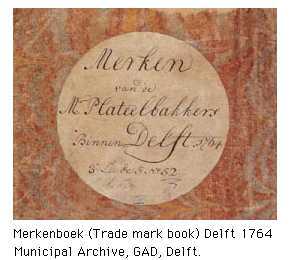 Elsewhere
on my home page you will find a clickable map of all Delftware
workshops with all sites of Delftware workshops and showing all
available potter's marks. These I have gathered from two sources. 1)
Jean Justice, 'Dictionaire des marques et monogrammes de la
faience de Delft', Gand/Gent 1901. 2) The 1764 Delftware Marks
collected by the city magistrate ("Merken van de Mr Plateelbakkers
binnen Delft 1764"). Both have been reproduced in full for each
workshop.
Elsewhere
on my home page you will find a clickable map of all Delftware
workshops with all sites of Delftware workshops and showing all
available potter's marks. These I have gathered from two sources. 1)
Jean Justice, 'Dictionaire des marques et monogrammes de la
faience de Delft', Gand/Gent 1901. 2) The 1764 Delftware Marks
collected by the city magistrate ("Merken van de Mr Plateelbakkers
binnen Delft 1764"). Both have been reproduced in full for each
workshop.
Full presentation on a clickable map and all workshops at http://www.xs4all.nl/~kalden. Email kalden@xs4all.nl
Making of Delfts blauw plateel? Tekst in Dutch / Nederlands.
Visit The Hague municipal Gemeentemuseum site on Delft Blue.
PLEASE note, I am not a specialist or trader !!! For more information on trading Dutch Delftware, you may wish to contact Aronson by email specializing in Dutch Delftware, run by Robert Aronson fifth generation in a traditional family business founded in 1881.
This is a link leading to the list of all known workshops. There is also a clickable map of Delft. For this clickable map of all workshops please go to Delft Blue section which is on view at www.xs4all.nl/~kalden
Launched January 2002. Last update October 25, 2016.
How did they produce Delft blue faience porcelain, how did they make delft blue?, production process, step by step, technology, process listing, in
delftware potteries, how do they do it, Marion S.van Aken-Fehmers, 'Delfts Aardewerk, Geschiedenis
van een nationaal product Jean Justice, 'Dictionaire des marques et monogrammes
de la faience de Delft' Delftware pottery production explanation, by Kees Kaldenbach.